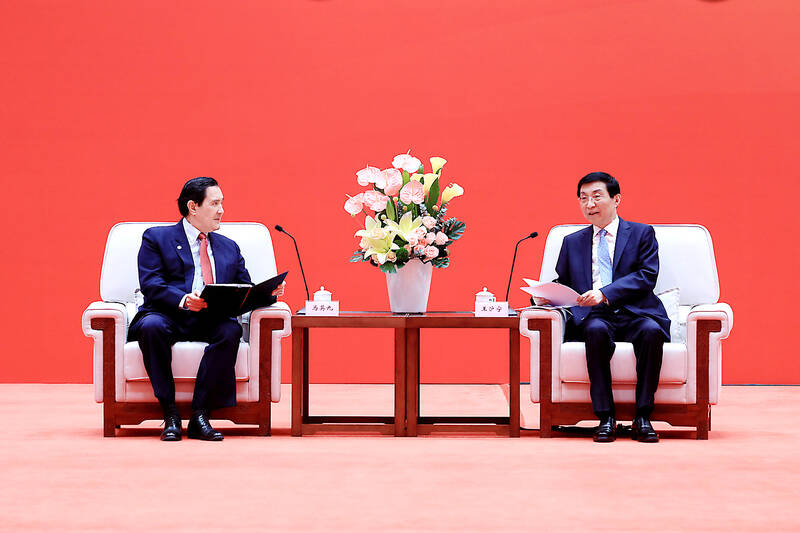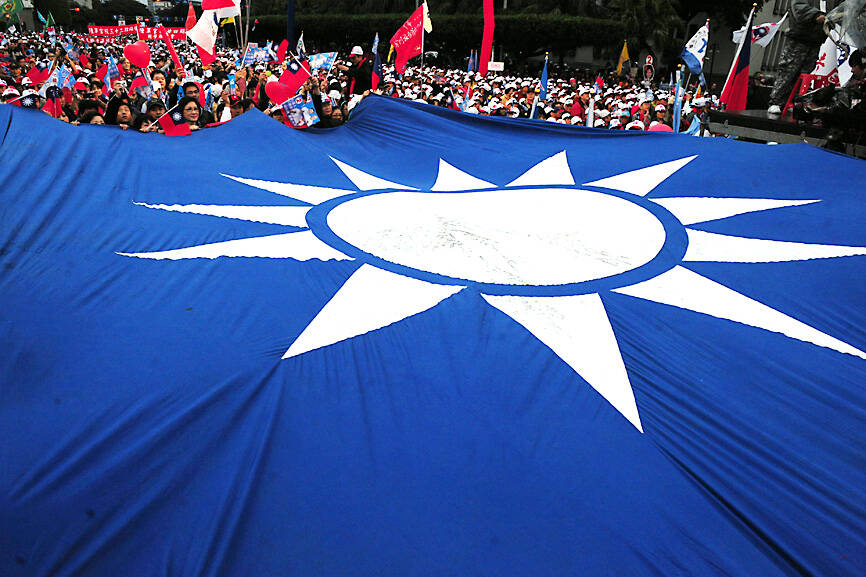There is an old British curse, “may you live in interesting times,” passed off as ancient Chinese wisdom to make it sound more exotic and profound.
We are living in interesting times. From US President Donald Trump’s decision on American tariffs, to how the recalls will play out, to uncertainty about how events are evolving in China, we can do nothing more than wait with bated breath.
At the cusp of potentially momentous change, it is a good time to take stock of the current state of Taiwan’s political parties.

Photo courtesy of the Ma Ying-jeou Foundation
As things stand, all three major parties are struggling.
For our examination of the Taiwan People’s Party (TPP), see a previous edition of this column (“Huang Kuo-chang’s choking the life out of the TPP,” May 28, page 12).
The Democratic Progressive Party (DPP) was detailed in last Saturday’s column (“Challenges amid choppy waters for the DPP,” June 14, page 12).

Photo: AFP
HISTORICAL BAGGAGE
The KMT suffers from long-standing systemic and historical problems that are hard to overcome.
Towering over the KMT electorally is their core “one China principle.” This states that Taiwan is unambiguously a province of China, and is embedded in the KMT-backed “1992 consensus.”

Photo: AFP
Many in the party maintain close ties to China and the Chinese Communist Party (CCP).
Despite promising to increase defense spending to over three percent of GDP, former President Ma Ying-jeou (馬英九) slashed defense spending and came close to handing over Taiwan to the CCP through a services pact that would have allowed them to control strategically critical industries.
These included telecommunications, media, finance, infrastructure, health and much more that would have made it impossible to keep secrets or adequately defend the nation, leaving Taiwan a tributary state at best.
The public reacted, backing the Sunflower Movement in 2014, ending Ma’s attempts at paving the way for unification, a goal he has admitted to trying to accomplish.
Though the party has earned a reputation for effective local governance, since Ma’s presidency, the party has been widely distrusted at the national level over fears of selling out Taiwan’s sovereignty.
The KMT leadership is aware of this, but efforts to restore public trust by abandoning their core “one China” ideology and the deeply unpopular “1992 consensus” have failed due to strong internal resistance. Party leaders and party members remain deeply committed.
Doubling down, Ma is currently in China and used the opportunity to praise Chinese leader Xi Jinping (習近平) for “striving to develop cross-strait peace,” despite increasing military intimidation of Taiwan.
Democratic electorates dislike political parties staying in power for too long, and after eight years of DPP rule, the KMT should have been well-positioned to win the presidency last year.
Yet, voters re-elected a DPP president, though by a much lower margin. By a fairly wide margin, voters picked DPP lawmakers over the KMT, but electoral math gave the KMT the edge and a plurality in the legislature.
As Taiwanese voters have always done, they voted in a third party, in this case the KMT-allied TPP, giving the pan-blue KMT-TPP alliance a legislative majority and a check on the executive branch.
It is popular among KMT politicians to point out that 60 percent of voters did not vote for William Lai (賴清德) as president.
This is factually true, but their implied message that had it been a two-way race with the KMT’s Hou You-ih (侯友宜) instead of a three-way race including the TPP’s Ko Wen-je (柯文哲), Lai would have lost does not hold up.
Facing a seven-point deficit, theoretically, Hou would have won if he had gotten around two-thirds of Ko voters. The problem is Ko voters did not want either the KMT or DPP.
These voters knew their vote would be a safe protest vote against the two major parties. Polling clearly showed a Lai victory on the horizon.
Given a starker choice of Lai versus Hou, some would have voted for Lai over concerns of the closeness of the KMT to the CCP. Others would have stayed home in protest, making Hou’s task even harder.
The result would have been closer, but Lai still had the advantage.
However, by 2028 the DPP will have been in power for 16 years.
This should give the KMT the upper hand, if they can figure out how to overcome suspicions over their “one China” stance and ties to China.
Providing vision on economic and social issues would also go a long way to capturing swing voters tired of DPP rule. This is especially true of younger voters who, by then, will have known nothing but DPP dominance.
DEMONIZING THE DPP
The KMT is not currently showing much vision or positive leadership. Alongside their TPP allies, their legislative majority has shown more interest in hamstringing the DPP administration than in proposing legislation that inspires voters.
It is unlikely that the KMT will make significant moves to tackle major problems like anemic wage growth, skyrocketing property prices, plunging demographics and underweight consumer spending.
The current system was put in place by the KMT, and the DPP has so heavily bought into this system that neither party has the stomach to enact changes. The elites and older demographic bases in both parties are too entrenched in profiting from this system to be willing to endure the painful changes necessary.
This should be fertile ground for the TPP and their younger demographic base, but they are showing no significant leadership on these issues.
Currently lacking any significant alternative vision, both the KMT and the TPP have doubled down on trying to demonize and delegitimize the DPP instead.
In a democracy, a key role of opposition parties is to probe and question to hold the government to account, and in some cases, they did an excellent job, such as exposing the Ultra Source egg importation scandal.
Many of their attacks ring hollow, however.
KMT claims of the DPP “dictatorship” weaponizing the judiciary to detain pro-KMT recall campaign staffers over allegedly forging signatures of names in KMT membership rolls, regardless of their mortal status, are simply diversionary. Prosecutors are working off data collected by local election officials with ties to local KMT governments.
The large number of confessions by KMT recall campaigners and the KMT’s Keelung mayor apologizing for an official allegedly using government household registration data suggest the prosecutors are doing their jobs, not persecuting the KMT.
CHAIR RACE
The party is also facing an ongoing financial crisis and is burdened with crushing debt. Best case scenario is they work through the debt over the next decades; worse case, creditors come knocking and the house of cards falls.
Short term, they are also facing a party chair election in September, which could trigger infighting. Calls are growing to suspend the election, but so are voices supporting Taichung Mayor Lu Shiow-yen (盧秀燕), increasing the uncertainty.
How this plays out will be crucial to the future of the KMT and potentially Taiwan.
Incumbent party Chairman Eric Chu (朱立倫) has proven a very capable party leader. He has restored the KMT’s electoral standing as a formidable party.
He has also had considerable success at keeping the party financially viable.
What Chu lacks is an articulate path forward for the party. He is not a visionary. His positions frequently change, sometimes in the same day, depending on the audience.
Lu has shown herself a solid leader and is appealing to mainstream voters.
This is a good base to work from, but she has yet to be rigorously tested, and crucially on where she stands on China-related issues.
Hou started from a similar position, but never moved beyond vague KMT platitudes, leaving the public unclear where he stood on China. It is not even clear if he had a clear personal stance.
Donovan’s Deep Dives is a regular column by Courtney Donovan Smith (石東文) who writes in-depth analysis on everything about Taiwan’s political scene and geopolitics. Donovan is also the central Taiwan correspondent at ICRT FM100 Radio News, co-publisher of Compass Magazine, co-founder Taiwan Report (report.tw) and former chair of the Taichung American Chamber of Commerce. Follow him on X: @donovan_smith.

Many people noticed the flood of pro-China propaganda across a number of venues in recent weeks that looks like a coordinated assault on US Taiwan policy. It does look like an effort intended to influence the US before the meeting between US President Donald Trump and Chinese dictator Xi Jinping (習近平) over the weekend. Jennifer Kavanagh’s piece in the New York Times in September appears to be the opening strike of the current campaign. She followed up last week in the Lowy Interpreter, blaming the US for causing the PRC to escalate in the Philippines and Taiwan, saying that as

Nov. 3 to Nov. 9 In 1925, 18-year-old Huang Chin-chuan (黃金川) penned the following words: “When will the day of women’s equal rights arrive, so that my talents won’t drift away in the eastern stream?” These were the closing lines to her poem “Female Student” (女學生), which expressed her unwillingness to be confined to traditional female roles and her desire to study and explore the world. Born to a wealthy family on Nov. 5, 1907, Huang was able to study in Japan — a rare privilege for women in her time — and even made a name for herself in the

This year’s Miss Universe in Thailand has been marred by ugly drama, with allegations of an insult to a beauty queen’s intellect, a walkout by pageant contestants and a tearful tantrum by the host. More than 120 women from across the world have gathered in Thailand, vying to be crowned Miss Universe in a contest considered one of the “big four” of global beauty pageants. But the runup has been dominated by the off-stage antics of the coiffed contestants and their Thai hosts, escalating into a feminist firestorm drawing the attention of Mexico’s president. On Tuesday, Mexican delegate Fatima Bosch staged a

Would you eat lab-grown chocolate? I requested a sample from California Cultured, a Sacramento-based company. Its chocolate, not yet commercially available, is made with techniques that have previously been used to synthesize other bioactive products like certain plant-derived pharmaceuticals for commercial sale. A few days later, it arrives. The morsel, barely bigger than a coffee bean, is supposed to be the flavor equivalent of a 70 percent to 80 percent dark chocolate. I tear open its sealed packet and a chocolatey aroma escapes — so far, so good. I pop it in my mouth. Slightly waxy and distinctly bitter, it boasts those bright,